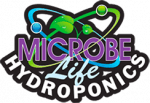Plants need all the elements or “building blocks” required to make more plant tissue. This includes nitrogen, phosphorus, and potassium (NPK), which are called macronutrients, as they are required in relatively large quantities. Carbon is required in even larger quantity. Carbon comes from Carbon fixation in photosynthesis and is also received through organic compounds in soils after being broken down by soil bacteria. Other elements required in smaller quantities, elements such as sulfur, calcium, magnesium, and manganese are referred to as micronutrients. Complex specific beneficial organics are produced by bacteria in soil.
There are four types of microorganisms in the MICROBE Life Hydroponic series including:
The bacteria in MICROBE Life break down organic compounds in the soil releasing elements that the plant can readily absorb. In addition, they work on elements present in the soil to convert them to more soluble, absorbable forms.
Photosynthesis is the process by which plants grow. Plants contain chlorophyll that utilizes light energy from the sun to convert carbon dioxide CO2, water, and minerals to oxygen and organic compounds such as sugars. The CO2 consumed and O2 produced by this process maintains the natural balance of these compounds in our atmosphere.
Plants also contain carotinoids that aid in capturing light energy from the sun and help protect the plant from sun damage. MICROBE Life contain two photosynthetic strains that enhance photosynthesis including improving the efficiency and effectiveness of CO2 fixation.
Plant photosynthesis is an oxygenic or oxygen producing reaction. The microbes in MICROBE Life do not produce oxygen.
Like plants, the photosynthetic organisms in MICROBE Life products harness the sun’s rays to produce energy, but they have a different form of chlorophyll (known as bacterio-chlorophyll) that utilizes a different and wider range of the light spectrum. Their metabolic capabilities are extremely versatile. They can metabolize with or without oxygen. Their photosynthetic process can produce hydrogen gas from either carbon-based or nitrogen-based compounds which include Hydrogen. Alternatively, they can convert hydrogen sulfide to elemental sulfur. These highly versatile bacteria can degrade a wide range of complex organic compounds to release energy and make nutrients available to plants.
Like plants, these bacteria use photosynthesis to generate energy for their growth and for utilization by other living systems.
A dense and balanced microbial population in the plant ecosystem can:
The bacteria in MICROBE Life provide energy from photosynthesis and excellent capability to degrade organics and out-compete pathogens, thus, Helping provide energy and populate a vigorous soil ecosystem. Not only do bacteria aid plants directly, but they also help feed higher organisms that provide vital functions as well.
Beneficial bacteria grow in the rhizosphere where they breakdown complex organics and provide auxins, hormones, and other nutrients that help the plant grow. These bacteria work synergistically with Mycorrhize.
Mycorrhizae are specialized filamentous, soil fungi that attach to plant roots, basically providing a more extensive matrix for accessing nutrients and moisture. There are two types, the “endo” type is utilized by most plants, while the “ecto” type is most beneficial to woody shrubs and trees. MICROBE Life products contain both types.
Some bacteria, notably the Bacilli, produce a protective form in unfavorable growth conditions as a survival mechanism. Spores provide long-term survival during desiccation (for dry products) and protect the organism when formulated in unfavorable liquids. However, these spores require time to germinate (just like a seed) which delays their action during product use. Bacillus spores are the most common form of spore microbe used in L&G formulations because of their stability. While Bacillus spores are very effective at providing some compounds useful to plant growth and pathogen resistance, there are many capabilities they do not provide such as pesticide and herbicide degradation, nitrogen and carbon fixation, etc. When the spores germinate and become active they are considered to be in the vegetative or “growing” form.
Many organisms are not capable of producing spores. They are always in the active form where they perform immediately upon application. However, it is much more difficult to maintain these strains in a stable formulation. MICROBE Life has a unique, stable formulation of vegetative strains with excellent shelf-life.
No other product in the Hydroponics, Grower Lawn and Garden markets contain the same stable photosynthetic strains of Rhodopseudomonas palustris and Rhodospirillum rubrum. These are extremely powerful microbes that provide energy, protect plants from sun damage, fix nitrogen and carbon dioxide, and provide a wide range of degradative capabilities to breakdown chemical contaminants.
No other product on the market contains as diverse a consortium of stable, vegetative strains that go to work immediately to breakdown both organics for food and toxic compounds that weaken plants, outcompete pathogens, and support a vigorous soil web.
No other product combines the photosynthetic and vegetative strains with nitrogen-fixing organisms to reduce fertilizer requirement and reduce fertilizer run-off, organisms capable of nitrification to convert nitrogen compounds into forms usable to the plant, and denitrifiers to complete the nitrogen cycle.
Plant photosynthesis is a two-step process. The Calvin-Benson cycle represents the second phase of plant photosynthesis. This light-independent Calvin cycle, also known as the “dark reaction”, uses the energy from electrons produced in phase one, to convert carbon dioxide and water into organic compounds such as glucose that can be used by the organism (and by animals that feed on it). This set of reactions is also called carbon fixation.
It was discovered by Melvin Calvin, James Bassham, and Andrew Benson at the University of California, Berkeley.
